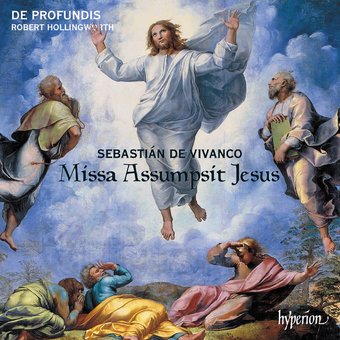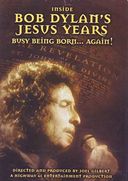De Profundis Vivanco:Missa Assumpsit Jesus

| Price: | $18 |
| List Price: |
|
| You Save: | $1.98 (10% Off) |
|
Brand New
|
CD Details
- Released: June 29, 2018
- Originally Released: 2018
- Label: Hyperion
Tracks:
- 1.De Profundis, Sam Barrett & Robert HollingworthIlluxerunt coruscationes tuae
- 2.Robert Hollingworth & De ProfundisMissa Assumpsit Jesus: I. Kyrie
- 3.De Profundis, Mark Dourish, Graham Kirk & Robert HollingworthMissa Assumpsit Jesus: II. Gloria
- 4.De Profundis, Sam Barrett & Robert HollingworthSpeciosus forma
- 5.Rob Humphries, De Profundis, Sam Barrett & Robert HollingworthAlleluia. Candor est lucis aeternae
- 6.De Profundis, Mark Dourish, Graham Kirk & Robert HollingworthMissa Assumpsit Jesus: III. Credo
- 7.Robert Hollingworth & De ProfundisAssumpsit Jesus Petrum
- 8.Robert Hollingworth, De Profundis & Graham KirkPer omnia saecula – Vere dignum – Quia per incarnati
- 9.Robert Hollingworth & De ProfundisMissa Assumpsit Jesus: IV. Sanctus & Benedictus
- 10.Robert Hollingworth & De ProfundisMissa Assumpsit Jesus: V. Agnus Dei
- 11.Robert Hollingworth & De ProfundisO sacrum convivium
- 12.Robert Hollingworth & De ProfundisDominus vobiscum – Ite, missa est
- 13.Robert Hollingworth & De ProfundisDe profundis
- 14.Robert Hollingworth & De ProfundisVersa est in luctum
- 15.Robert Hollingworth & De ProfundisSurge, propera, amica mea
- 16.Robert Hollingworth & De ProfundisAssumpta est Maria
- 17.Robert Hollingworth & De ProfundisVeni, dilecte mi
- 18.Robert Hollingworth, De Profundis & Tristram CookeMagnificat primi toni
Product Description:
In 1608 Taberniel printed a collection of ten Mass Ordinaries, Vivancos Liber Missarum. It begins with a setting for six voice parts and ends with one for eight. There are seven for four voices and one for fivethe Mass recorded here. Missa Assumpsit Jesus is presented in a context of the Feast of the Transfiguration of Our Lord (6 August). The title and the main melodic basis of the Mass is taken from Vivancos own motet Assumpsit Jesus Petrum, which tells how Jesus took Peter along with James and John up to a high place where he was transfigured, and there endorsed by Gods voice of approval from a high cloud. The first part of this text served as a Vespers antiphon for the Transfiguration feast, but Vivanco originally wrote it in full as a Gospel motet for the Second Sunday of Lent. Here we use it as an extra-liturgical motet in place of the Offertory. The plainchant of the Introit, Gradual and Alleluia verse are taken from the Roman Gradual published in 1614, as are the responses and Preface before the Sanctus. The deeply devotional Eucharistic motet O sacrum convivium (to the words of Thomas Aquinas) concludes our choice of Mass music.
Vivanco was an enthusiast for complex canons. The Osanna II for seven voices has three of them derived from a diagram of music notation with recondite Latin instructions. The notation has signs for entries and departures, plus mensural time signatures, some reversed, all governing the voices motions, forward and backwards, in full time values and in diminution (doubling of speed), all using a nine-note version of the main theme of the Mass, itself derived from the opening melodic line of the motet Assumpsit Jesus: a rich but impenetrable aural experience. It is a relief to hear the crystal clear canons (of imitation at the unison) for the top voices in the Credos Crucifixus and in the Agnus Dei.
Following the Dismissal, Go, Mass is ended. Thanks be to God, we present motets of penitence and mourning followed by three that honour the Blessed Virgin. De profundis, the Psalmists cry out of the depths, is a brief setting in which the composer uses some agitated figures, enhanced chromatically, to plead for mercy. On a grander scale, Versa est in luctum mourns the passing of some important person. Vivancos motet is one of a contemporaneous trio of six-voiced settings of this text (the Office of the Dead): the others are Alonso Lobos for Philip II from 1598, and Victorias for the dowager Empress Maria from 1603. Vivancos was not included in his book of 1610 and may have been composed a few years later.
The Marian motets have the composer in joyful mood. The two that have texts from the biblical Song of Songs are for two equal choirs. They both begin with flowing imitative entries in typical sixteenth century polyphonic style, but soon they settle into a declamatory mode, mostly call-and-answer from choir to choir. The rhythmic variety of patter, sometimes syncopated, is very lively. Vivanco uses these resources to change pace. Some grandeur is achieved when the choirs eight voices come together in rich sonority. The Songs were drawn from the Vulgate Bible because the Church interpreted them as depicting the mutual love of Christ and his spouse the Church. As Marian devotion increased, many passages became associated with the Blessed Virgin: Vivancos printed heading for Veni, dilecte mi is De Beatae Mariae. There are many delightful touches in Surge, propera, amica mea: those treasured words hiems transiit, imber abiit et recessit (now the winter is past, the rain is over and gone) are set in gentle repetition and then in full choir harmony, into which spring suddenly burstsFlores apparuerunt in terra nostra (The flowers appear in our land)in rapid-fire parlando style.
Assumpta est Maria is something else. The text is the first antiphon at Vespers of the Feast of the Assumption of the Blessed Virgin Mary. Vivancos motet could have been used to replace the plainsong that would follow the Psalm Dixit Dominus; more likely is its extra-liturgical use on that joyful feast, for it has an added Alleluia. It is written for six voices, three of them equal superius parts that continually cross, weaving around each other to shimmering effect. Two tenors supported by a baritone complete the six in the same way, constantly in close imitation. This is an unbroken web of lively counterpoint, very bright, with joyous leaps, syncopations and runs.
The recording ends with a setting of the Marian canticle, the Magnificat. The Liber Magnificarum (1607) consisted of two complete cycles of polyphonic verses to be sung in alternation with plainsong. One cycle has polyphony for the odd-numbered verses, the other sets polyphony for the even verses. There are eight settings to each cycle, employing each of the eight plainchant recitation tones. To these sixteen Magnificats Vivanco added two more, one at the beginning of the book and one at the end: an extra primi toni for six voices and an octavi toni for eight voices. The latter has gained some currency in a modern edition, recorded by Westminster Cathedral Choir. The former ends this programme.
The Magnificat primi toni is for six voices (with double superius and tenor parts), reduced in verse five, Et misericordia, to just four, expanding to eight in the doxology Gloria Patri; in that final verse Vivanco plays his tricks. He presents three canons: one instructs a voice to be copied an octave higher, omitting all the smallest notes and the longest; one of the tenor parts is to be imitated at the fourth above; the bass voice is to be imitated by another bass who must reverse all the intervals, going down when the leader goes up, and vice versa, singing three bars behind. All very clever, but you will probably hear just a gorgeous sonic tapestry.























![Tesoros de Coleccion [Video] Tesoros de Coleccion [Video]](https://d1wj8oqehjepyy.cloudfront.net/i/boxart/w128/42/81/735978428159.jpg)







